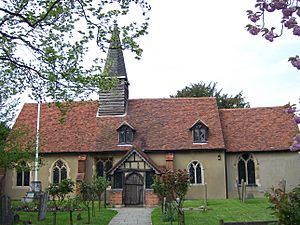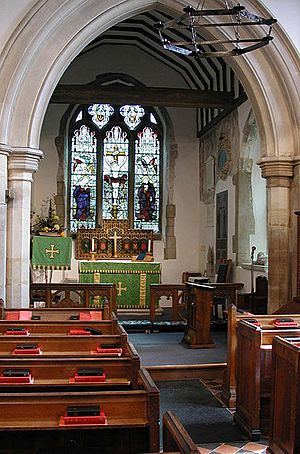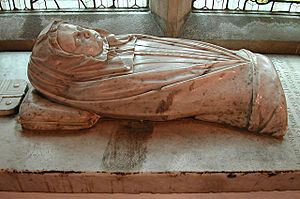St Giles' Church, Ickenham facts for kids
Quick facts for kids St Giles' Church |
|
|---|---|
| Parish Church of St Giles | |

St Giles' Church, viewed from the entrance of the churchyard
|
|
| Location | St Giles' Church, Swakeleys Road, Ickenham |
| Country | United Kingdom |
| Denomination | Church of England |
| Website | St Giles' Church, Ickenham |
| History | |
| Dedication | Saint Giles |
| Consecrated | 1335 |
| Architecture | |
| Years built | 1335 |
| Administration | |
| Diocese | London |
St. Giles' Church is an old church in Ickenham, a part of the London Borough of Hillingdon in England. It stands right in the middle of Ickenham, where Swakeleys Road and Long Lane meet.
The oldest parts of the church, like the main hall (called the nave) and the area around the altar (called the chancel), were built way back in 1335. Over the years, more sections have been added. Inside, you can find special memorials that remember important families from Ickenham's past.
Contents
History of St Giles' Church
Ickenham is mentioned in the Domesday Book by the name "Ticheham." However, this old book does not mention a church in Ickenham itself. People believe that residents of Ickenham used to travel to the nearby parish of Harefield for church services.
Early Days and Building
The first parts of St Giles' Church, the nave and chancel, were built in 1335. Later, in 1959, the nave was made longer towards the west. The bell tower was built in the 1400s, and a new section called the north aisle was added in 1575.
A man named William Say paid for the bricks for the north aisle. He expected to be paid back later. Special seats, called pews, were put in the aisle for Say's family. Back then, it was common for people to stand or kneel during church services. William Say wrote his will in March 1582, just before he died. He wanted to be buried inside this new aisle. He also said that the money the church owed him could be reduced a little bit for each member of his family buried there.
William Say is remembered in the church with a special brass memorial. It shows him, his wife Isabel, and their two children. His son, Robert, died in 1584 and has his own brass memorial.
Important Families and Memorials
There is a memorial inside the church for Robert Clayton. He was the baby son of Sir Robert and Dame Martha Clayton. This memorial is on a windowsill and looks like a sleeping baby. Robert was buried in the chapel for the Swakeleys manor, which was in the north aisle. He died just a few hours after being born in August 1665 at Swakeleys House. His parents were staying there to escape the Great Plague, a very serious illness that was spreading in London. Sir Robert later became the Lord Mayor of London in 1679.
Thomas Vyner, who was the nephew of Sir Robert Vyner, was buried in the Swakeleys chapel in 1907. He had actually died in Rome. By 1914, the Swakeleys chapel was full. The church decided to move the coffins to the churchyard. At this time, Robert Clayton's memorial was moved from his coffin to the windowsill. A new doorway was built in 1918, connecting the old chapel to the main church.
Remembering Wars and Community
Inside the church, there is a plaque that honors the men from the village who died in the First World War. This plaque is considered a Grade II listed item by the Church of England. The rail around the altar is dedicated to the young people from the church who died during the Second World War. Their names are also on a nearby plaque. Another memorial for those killed in the war is the Book of Remembrance. Two stained glass windows in the south aisle remember the Middlesex Regiment and the Home Guard.
In the 1980s, the church celebrated its 650th anniversary. To mark this special occasion, it formed a partnership with the United Reformed Church, which is also in Ickenham on Swakeleys Road.



